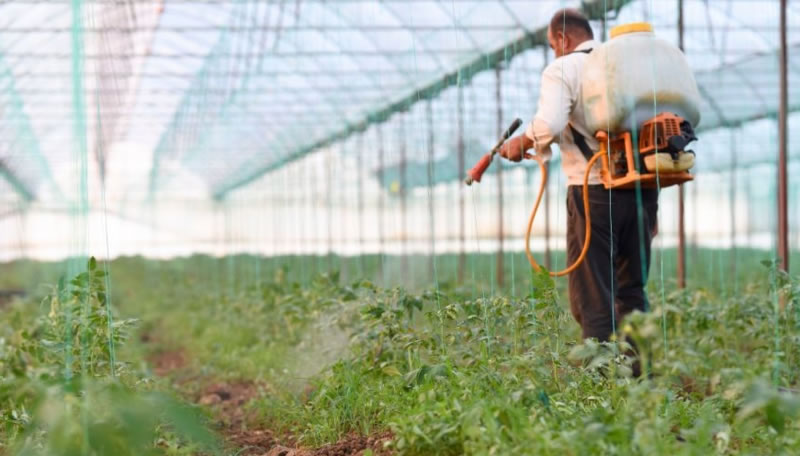Introduction
Farming is a crucial industry that provides food and sustenance to communities all over the world. However, crop farming comes with its own set of challenges, one of which is dealing with pests and diseases that can damage crops and reduce yields. For generations, farmers relied heavily on chemical pesticides to control pests and protect their crops. While pesticides are effective in the short run, overuse and misuse of chemicals can have unintended negative consequences. It can harm beneficial and non-target organisms, contaminate soil and water sources, and build pest resistance over time.
Thankfully, integrated pest management, also known as IPM, provides a smarter and more sustainable alternative to conventional chemical-dependent methods. IPM utilizes a multi-pronged approach that combines various cultural, mechanical, biological, and chemical control techniques in a way that minimizes risks to people and the environment. The core idea is to disrupt pest reproduction and development through a variety of complementary methods rather than total reliance on synthetic chemicals alone. IPM helps farmers grow healthy crops cost-effectively while protecting workers, consumers and the surrounding ecosystem.
In this blog post, I will provide a comprehensive overview of integrated pest management practices and demonstrate how IPM strategies can be effectively implemented in various crop farming systems. I will discuss specific IPM techniques for different pest types, the importance of monitoring and decision making, as well as challenges and opportunities in IPM adoption. My goal is to educate readers about the benefits of adopting IPM and encourage more sustainable pest control in agriculture. So let's get started!
What is Integrated Pest Management?
Integrated pest management, commonly referred to as IPM, is a multi-faceted approach for managing pests in a way that minimizes risks to health and environment. As defined by the US Environmental Protection Agency, "IPM is an effective and environmentally sensitive approach to pest management that relies on a combination of common-sense practices. IPM programs use current, comprehensive information on the life cycles of pests and their interaction with the environment. This includes information on the pest's identity, biology and habitat needs; historic information related to prevalence and severity of a pest; and a series of cultural, physical, biological and chemical pest management methods to be used with sensitivity, skill and knowledge of their impact on human health, non-target organisms and the environment."
The key principles of integrated pest management include:
- Preventive pest control through various cultural methods like sanitation, habitat management, resistant crop varieties, altering planting dates etc.
- Monitoring and accurate pest identification to determine when control tactics are needed.
- Setting action thresholds - acting only when monitored pest numbers surpass predetermined levels that cause unacceptable damage.
- Using a variety of complementary pest control methods like biological control, cultural practices and targeted chemical applications.
- Modifying control practices based on ongoing pest monitoring to ensure long-term pest suppression.
The goal of IPM is to disrupt pest reproduction and weaken pest populations through diverse targeted techniques instead of sole reliance on pesticides. When implemented properly, it provides an effective and low-risk approach to managing pests.
IPM Techniques for Different Pest Types
Now let's explore some of the common IPM techniques farmers can use for different types of crop pests:
Weeds: Cultural techniques form the foundation for weed control in IPM. These include proper tillage, competitive crop varieties, crop rotation, and cover cropping. Mechanical control through hand weeding or cultivation equipment is also important. Targeted use of pre-emergent and post-emergent herbicides can complement cultural practices.
Insects: Methods revolve around conservation of natural enemies through habitat manipulation. This includes providing pollen and nectar sources to sustain beneficial insect populations. Biological controls using parasitoids and predators are emphasized. Monitoring is done through pheromone traps and visual inspection. When needed, selective insecticides are judiciously applied.
Diseases: Cultural control via crop rotation, resistant varieties, proper fertilization and irrigation helps prevent diseases. Sanitation practices like removing plant debris and volunteer plants reduce the reservoir of infectious material. Biologicals like rhizosphere microbes can induce host plant resistance. Fungicides are applied only under high risk situations as determined through surveillance.
Nematodes: Crop rotation to non-host plants is the primary technique to manage nematode pests. Resistant varieties are used where available. Biological alternatives such as fungal and bacterial antagonists as well as nematophagous fungi provide suppression. Nematicides are applied restrictively based on soil assays.
Rodents: Physical controls through habitat modification help deter rodents. Traps, bait stations and fumigants are used judiciously as a last resort, targeting specific problem areas. Cultural practices like sanitation and crop debris removal reduce food/shelter availability.
Integrating Multiple Methods
The key to effective IPM lies in thoughtfully integrating multiple complementary control practices versus piecemeal approaches. For example, combating a disease outbreak may involve:
- Planting resistant crop varieties as the frontline defense.
- Incorporating a cover crop to reduce carryover of disease pathogens in the soil.
- Optimizing fertilizer use to boost plant health and natural defenses.
- Removing symptomatic plant debris to limit the disease cycle.
- Releasing biocontrol microbes to protect roots from infection.
- Applying a protectant fungicide only if monitoring confirms high inoculum levels and favorable weather for disease spread.
Such layering of diverse preventive and intervention tactics, along with careful timing of activities, disrupts pest lifecycles far better than isolated actions. It provides insurance against treatment failure as well. Proper combinations tailored to the unique farm conditions deliver effective, low-risk pest management.
Monitoring and Decision Making
Monitoring is the backbone of any IPM program as it provides timely information to identify problems and guide control responses. Regular scouting is done to:
- Identify pests present in the field.
- Estimate pest population levels and distributions across different crop stages.
- Check the efficacy of ongoing control practices.
- Track climate, host conditions, natural enemy activities influencing pest issues.
Depending on the crop and pests involved, monitoring utilizes sampling techniques like visual inspections, pheromone/sticky traps, soil assays and plant checks. Accurate record keeping is important to discern patterns and trends over time.
Action thresholds play a big role in IPM decision making. They indicate when control actions are justified based on pest density levels and projected economic damage. Thresholds are flexible and factor in variables like susceptible crop growth stage, market value, control costs and feasibility. Intervention occurs judiciously when monitoring confirms pest counts above the pre-set benchmark. This avoids overuse of chemical inputs.
Monitoring data empowers periodic review of thresholds. It helps validate program effectiveness and efficiency through verifiable pest and cost impact assessments. Over subsequent cropping cycles, experiences are incorporated into the planning process each season, steadily improving IPM outcomes. Regular oversight and refinement is thus key to continuously optimize integrated strategies.

Weed Management through IPM
Effective weed control is essential in realizing optimal crop yields as weeds compete for water, nutrients and sunlight. IPM provides a systematic approach to suppressing weed pressure through combined practices:
- Cultural control forms the foundation. Practices like proper tillage, competitive crop varieties, and cover cropping establish are helpful. Field borders are managed to limit weed sources.
- Mechanical techniques involve manual or mechanical removal of weeds when still small using hand tools, tillage implements or specialized cultivators. This is aided by good within-row plant spacing.
- Biological methods leverage the allelopathic effects of plants like sorghum, sunflower and brazilian pepper to inhibit weed seed germination. Cover crops are selected for their competitive abilities and to crowd out weeds.
- Targeted use of herbicides: Pre-emergent herbicides are applied to the soil surface after seeding/transplanting to prevent germinating weed seeds. Post-emergent herbicides selectively control emerged weeds based on monitoring results. Care is taken to avoid harmful residues and resistant weed evolution.
- Monitoring pinpoints new and problematic weed species. Threshold guidelines determine when and where on the field herbicides may be judiciously needed as a supplement only during critical crop stages. Follow-up scouting checks treatment success.
An adaptive, integrated approach helps reduce herbicide quantities and selection pressures over time. Holistic weed management minimizes ecological impacts while still meeting crop production goals economically.
Implementing IPM - Farmers’ Perspective
While the underlying concepts may seem straightforward, transitioning to full-scale IPM implementation takes commitment and planning. Here are some practical considerations from a farmer’s perspective:
- Time and diligence are required for effective scouting, record keeping and decision making based on site-specific conditions. Investment in grower education and technical assistance eases this shift.
- Upfront investment may be needed for necessary monitoring tools, application equipment upgrades, beneficial insect habitat enhancement or cover cropping infrastructure. Cost-share programs help defray initial expenditures.
- Multi-year perspectives are important given that pest complex dynamics, natural enemy populations and program benefits all develop gradually over multiple seasons. Patience is warranted.
FAQs
FAQ 1: What crops can integrated pest management be used for?
IPM can be applied to virtually any annual or perennial crop. Some of the most common include field crops like corn, soybeans, wheat; vegetables including tomatoes, peppers, carrots; fruits such as apples, grapes, berries; and even plantation crops like coffee, cocoa and oil palm. By tailoring the specific techniques, IPM offers sustainable pest control across diverse cropping systems.
FAQ 2: How do I get started with IPM on my farm?
The first step is to conduct a thorough field assessment to identify key pests, their life cycles and natural enemies present. Then establish a regular monitoring schedule to stay updated on population fluctuations. Attend local IPM workshops to learn tried-and-tested strategies and guidelines. Implement preventive cultural practices and habitat enhancements in stages. Keep meticulous records for review and adjustments to continuously improve over time. Technical assistance is advisable, especially in the initial years of transitioning to full-scale IPM.
FAQ 3: What are some challenges in adopting IPM practices?
One challenge is the increased labor needs for activities like scouting and record keeping compared to reliance on simple chemical treatments. Upfront costs for certain tools, equipment and infrastructure modifications may also be prohibitive for some growers. Market pressures discourage shorter-term perspectives, preferring swifter fixes. Educating farm workers and building expertise also requires effort and persistence. Pest complexes are truly dynamic, necessitating constant vigilance and system refinement.
FAQ 4: How effective is IPM compared to conventional pest control methods?
Numerous studies have demonstrated that IPM, when diligently implemented, performs on par or better than standard chemical-based programs in terms of yield, quality and profitability. The integrated approach disrupts pest reproduction more thoroughly, boosts resilience to withstand occasional outbreaks, and dramatically cuts down pesticide usage and associated risks over the long haul. IPM operations also gain competitive advantages through reduced input and compliance costs as well as access to discriminating markets favoring sustainable production.
FAQ 5: Can IPM help with pest resistance issues?
Indeed, IPM strategies are directly beneficial for countering the development of pest resistance, a growing problem with over-reliance on chemical solutions. By utilizing diverse modes of action against pests, selection pressure for resistance traits is lower. The incorporation of cultural, biological and natural control elements as primary tactics restricts opportunities for pests to evolve immunity. Regular monitoring likewise enables early detection and adapted responses before resistance becomes entrenched range-wide.
FAQ 6: What are the environmental benefits of IPM adoption?
Significantly less pesticide runoff represents the biggest environmental gain, protecting nearby aquatic ecosystems and sources of drinking water. Natural enemy conservation within crop habitats also supports biodiversity and biological control services across broader landscapes. Decreased chemical usage lessens pollution hazards for farmworkers and rural communities. IPM additionally helps mitigate greenhouse gas emissions and fossil fuel usage associated with conventional inputs. Overall, adopting IPM principles greatly enhances the sustainability and resiliency of agroecosystems.
Conclusion
In conclusion, integrated pest management presents a knowledge-intensive yet highly effective approach suitable for any farming operation worldwide. With dedicated commitment and technical learning over multiple years, IPM helps farmers grow healthy crops profitably while safeguarding human and environmental health. Though implementation requires perseverance, the sustainability and pest control dividends of IPM make it a wise long-term investment for the future of agriculture.


